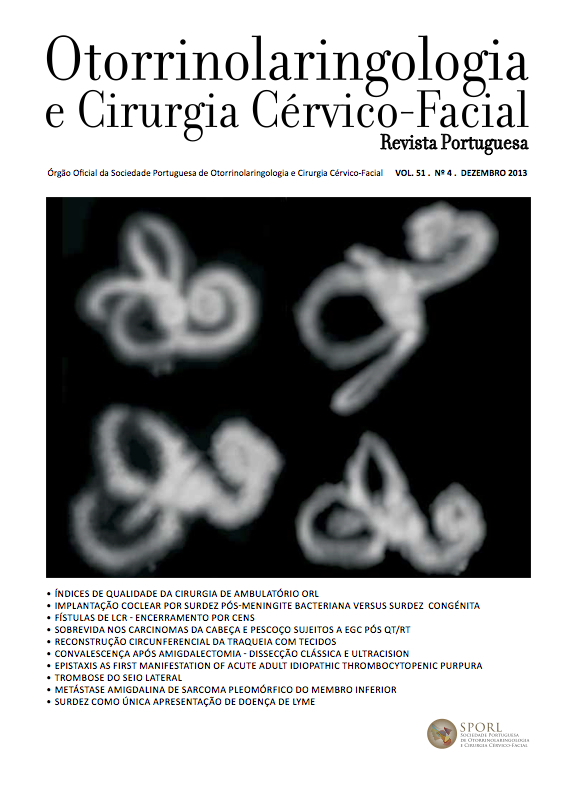Cerebrospinal fluid leaks: endoscopic transnasal repair
DOI:
https://doi.org/10.34631/sporl.46Keywords:
cerebrospinal fluid leak, endoscopic repairAbstract
Introduction: Cerebrospinal fluid leak (CSF) is characterized by the breakdown of all barriers that separate the subarachnoid space from the mucosa of the nasal cavity or paranasal sinus. The endoscopic transnasal techniques are nowadays a valid alternative for the repair of these anterior skull base defects. Matherial e Methods: Retrospective study considering all patients who underwent endoscopic transnasal CSF leak repair, from January 2005 to February 2012. Results: 27 CSF leaks, corresponding to 25 patients. The aetiology was spontaneous (40,8%), traumatic (37%), iatrogenic (18,5%) and tumoral (3,7%). The ethmoid was the most common site (52%), followed by the sphenoid sinus (37%) and multiple in 11% of the cases. The success rate, after the first closure attempt, was 88,9%. Conclusion: The endoscopic transnasal approach is an excellent option for the cranial base CSF leak repair. The correct location and exposure of the bone defect, and the proper placement and fixation of the graft, are of great importance for the success of this technique.
Downloads
References
Gilat H, Rappaport Z, Yaniv E. Endoscopic transnasal cerebrospinal fluid leak repais: a 10 year Experience. IMAJ, Oct 2011; 13: 597-599.
Bradford A, Woodworth, Rodney JS. Repair of anterior skull base defects and CSF leaks. In: Springer (Eds). Rhinologic and sleep apnea surgical techniques. NY 2007, pp139-146.
Wormald PJ. Cerebrospinal fluid leak closure. In: Thieme (Eds). Endoscopic Sinus Surgery: anatomy, three-dimensional reconstruction, and surgical
techniques. NY 2005, pp109-118.
Rice DH, Schaefer SD. Ancillary procedures. In: Lippincott Williams & Wilkins (Eds). Endoscopic Paranasal Sinus Surgery (3rd Edithion). Philadelphia 2004, pp265-272.
Presutti L, Mattioli F, Villari D, Marchioni D et al. Transnasal endoscopic treatment of cerebrospinal fluid leak: a 17 year’s experience. Acta
Otorhinolaryngol Ital. Aug 2007; 29(4): 191-196.
Ezequiel B. Novos horizontes em cirurgia endonasal. In: Círculo Médico (Eds). Patologia naso-sinusal. Lisboa 2008, pp173-179.
Araujo Filho BC, Butugan O, de Melo Pádua FG, Voegels RL. Endoscopic repair of CSF rhinorrhea: experience of 44 cases. Rev Bras Otorrinolaringol.
Aug 2005; 71(4): 472-476.
Tosun F, Carrau RL, Snyderman CH, Kassam A et al. Endonasal endoscopicrepair of cerebrospinal fluid leaks of the sphenoid sinus. Archives of Otolaryngology-head &neck surgery. May 2003, 129(5): 576-580.
Husain M, Jha D, Vatsal DK, Husain N et al. Neuroendoscopic transnasal repair of cerebrospinal fluid rhinorrhea. Skull Base. May 2003, 13(2): 73-78.
Landeiro JA, Flores MS, Lázaro CR, Melo MH. Surgical management of cerebrospinal fluid rhinorrhea under endoscopic control. Arq Neuropsiquiatr.
, 62(3-B): 827-831.
Gulsen S, Yilmaz C, Aydin E, Kocbiyik A et al. Meningoencephalocele formation after nasal septoplasty and management of this complication.
Turkish Neurosurgery. 2008, 18(3): 281-285.






